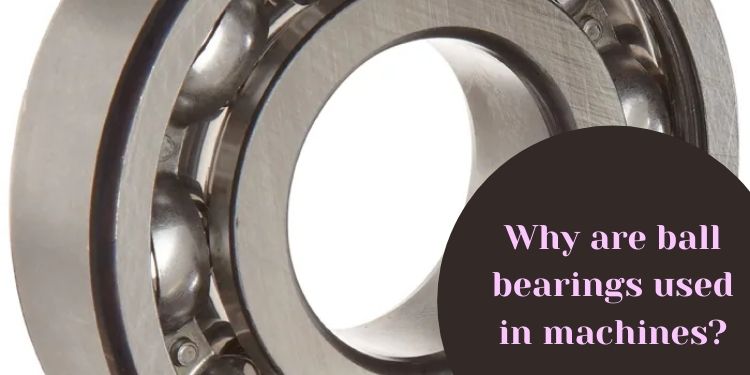Why are ball bearings used in machines?

Everywhere in industry and wherever moving parts are in operation, there is probably a need for constant velocity joints. Especially when it comes to connecting stationary and moving parts to eliminate friction losses.
When carefully sourced – for example, from Abdul Traders, bearing supplier – these ball bearing joints protect moving parts from frictional damage, such as premature wear or failure of connecting parts.
Table of Contents
ToggleAn introduction to ball bearings
Ball bearings consist of a fixed housing and a rotating shaft. Together, they are the solution to get the cogs turning in many industrial applications.
When buying ball bearings, it is important to understand what exactly a ball bearing is, how it works, and what types of ball bearings are suitable for your mechanisms.
The most common ball bearings are made up of five main components. They all work closely together to provide smooth stability and connection between two components.
1. the steel balls
Starting from the center of the ball bearing, the steel balls play the most important role in performing the function. They are the rolling element of the bearing.
2. the cage
The cage holds the balls in a uniform ring, which keeps them evenly spaced in the bearing. The cage can be made in various shapes and is designed with low friction materials to allow the balls to roll freely.
3. the inner ring
The inner ring (also called the inner race) is a smaller part on which the ball bearings sit on a radial axis. In most cases, it is the inner ring that rotates because it is connected to the moving parts. The inner and outer rings (see below) have the same bandwidth, but different ring diameters to allow the balls to be inserted.
4. the outer ring
The outer ring (also called the outer race) is the larger ring under which the balls move on a radial axis. Since the inner ring is typically in motion, the outer ring is the stagnant component. Both the outer ring and the inner ring have grooves of different depths to allow the rolling elements to slide without deviation.
5. the shield
Finally, the bearing shield is an optional component of the ball bearing. However, it is highly recommended to buy ball bearings that are equipped with a shield. The reason for this is that they last longer, as the shield is a cover that conceals the rolling element. They can be made of either metal to prevent dust buildup or plastic to increase water resistance. At the same time, these covers help retain oil and grease, so less maintenance is required as the bearing is lubricated throughout its life.
In order to move properly, bearings require radial and axial clearance (internal clearance) of these five parts. This is to allow for the thermal expansion caused by the remaining friction during operation. This special allowance prevents the bearing from tightening, wearing, and seizing.
What types of bearings are available from a bearing supplier?
Bearings are not a one-size-fits-all industrial component. So when you contact a bearing supplier, you need to know which bearing is right for your operation and machine.
– Radial bearings are designed to withstand forces that are perpendicular to the access.
– Thrust bearings have balls sandwiched between races while resisting axial forces.
– Angular contact ball bearings are designed to withstand both perpendicular and axial loads.
– Roller bearings are used to reduce friction between moving parts and have a higher load-carrying capacity compared to ball bearings.
– Linear bearings allow movement in one direction, such as back and forth.
– Self-aligning bearings allow the axis to be tilted by double roller bearings during operation.
– Mounted bearings are used to support rotating parts or to separate rotating parts from stationary parts.
What are the main functions of ball bearings in machines?
Ball bearings are among the most commonly used mechanical parts and are used in both household and industrial applications, such as cars, hydraulic presses, bicycles, motorcycles, drills, joints, winding mechanisms, motors, turbines, office equipment, medical devices, and more.
That’s because they perform three important tasks:
1. they create frictionless resistance
Without the use of magnetic bearings (not a subspecies of ball bearings), there would be no frictionless resistance. Although they are often referred to as frictionless resistance components, they are actually friction-reduced resistance. While the balls minimize friction between two raceways, friction is still required to stabilize one raceway or the other. Allowing for this reduced friction resistance also means a reduction in temperature, wear rate, and the likelihood of part failure.
2. you connect two independent machine parts
In a mechanism, there is always a need to connect parts through joints. Ball bearings act as joints to connect two machine parts (sometimes with different axes) when one part rotates, such as the bicycle fork and its wheel.
3. they carry loads in the mechanism
Each ball bearing can support a load equal to the width of the outer ring. For this reason, self-aligning bearings with double roller capacity can carry a larger load and remain durable. Ball bearings have a static load-carrying capacity that is reflected in the axial load limits; some high-performance bearings can carry a load of up to 50% of the static load.
Why are ball bearings so important for industrial enterprises and enterprises?
As factories, manufacturing machines, and industrial operations evolve, more diverse applications are needed to reduce time, space, and downtime.
Because ball bearings are able to reduce goods between parts, effectively connect both moving and static components without manual operation, and support predetermined load amounts, they can significantly reduce the likelihood of mechanical failure.
Industries such as automotive purchase ball bearings and beyond to provide engines with reduced friction resistance to prevent temperature rises and component overloads. Using ball bearings to reduce friction improves the overall performance and efficiency of a vehicle while reducing CO2 emissions.
Alfred Williams, a distinguished business writer, navigates the corporate landscape with finesse. His articles offer invaluable insights into the dynamic world of business. Alfred's expertise shines, providing readers with a trustworthy guide through the complexities of modern commerce.
Recommended For You
Spread the loveThe name Broderick Bevineau makes you think of new ideas and starting your own business. Bevineau has made
Spread the loveThe popularity of Airbnb has paved the way for many entrepreneurs to build businesses in the short-term rental
Spread the loveCreating a well-designed and functional website starts long before coding begins. The prototyping phase is a critical step




